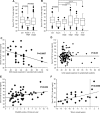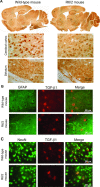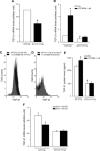Early defect of transforming growth factor β1 formation in Huntington's disease
- PMID: 20082658
- PMCID: PMC3922377
- DOI: 10.1111/j.1582-4934.2010.01011.x
Early defect of transforming growth factor β1 formation in Huntington's disease
Abstract
A defective expression or activity of neurotrophic factors, such as brain- and glial-derived neurotrophic factors, contributes to neuronal damage in Huntington's disease (HD). Here, we focused on transforming growth factor-β (TGF-β(1) ), a pleiotropic cytokine with an established role in mechanisms of neuroprotection. Asymptomatic HD patients showed a reduction in TGF-β(1) levels in the peripheral blood, which was related to trinucleotide mutation length and glucose hypometabolism in the caudate nucleus. Immunohistochemical analysis in post-mortem brain tissues showed that TGF-β(1) was reduced in cortical neurons of asymptomatic and symptomatic HD patients. Both YAC128 and R6/2 HD mutant mice showed a reduced expression of TGF-β(1) in the cerebral cortex, localized in neurons, but not in astrocytes. We examined the pharmacological regulation of TGF-β(1) formation in asymptomatic R6/2 mice, where blood TGF-β(1) levels were also reduced. In these R6/2 mice, both the mGlu2/3 metabotropic glutamate receptor agonist, LY379268, and riluzole failed to increase TGF-β(1) formation in the cerebral cortex and corpus striatum, suggesting that a defect in the regulation of TGF-β(1) production is associated with HD. Accordingly, reduced TGF-β(1) mRNA and protein levels were found in cultured astrocytes transfected with mutated exon 1 of the human huntingtin gene, and in striatal knock-in cell lines expressing full-length huntingtin with an expanded glutamine repeat. Taken together, our data suggest that serum TGF-β(1) levels are potential biomarkers of HD development during the asymptomatic phase of the disease, and raise the possibility that strategies aimed at rescuing TGF-β(1) levels in the brain may influence the progression of HD.
© 2011 The Authors Journal of Cellular and Molecular Medicine © 2011 Foundation for Cellular and Molecular Medicine/Blackwell Publishing Ltd.
Figures








Similar articles
-
Reduced expression of the TrkB receptor in Huntington's disease mouse models and in human brain.Eur J Neurosci. 2006 Feb;23(3):649-58. doi: 10.1111/j.1460-9568.2006.04590.x. Eur J Neurosci. 2006. PMID: 16487146
-
Rescue of BDNF expression by the thalamic parafascicular nucleus with chronic treatment with the mGluR2/3 agonist LY379268 may contribute to the LY379268 rescue of enkephalinergic striatal projection neurons in R6/2 Huntington's disease mice.Neurosci Lett. 2021 Oct 15;763:136180. doi: 10.1016/j.neulet.2021.136180. Epub 2021 Aug 17. Neurosci Lett. 2021. PMID: 34416343 Free PMC article.
-
Striatal phosphodiesterase mRNA and protein levels are reduced in Huntington's disease transgenic mice prior to the onset of motor symptoms.Neuroscience. 2004;123(4):967-81. doi: 10.1016/j.neuroscience.2003.11.009. Neuroscience. 2004. PMID: 14751289
-
Role of brain-derived neurotrophic factor in Huntington's disease.Prog Neurobiol. 2007 Apr;81(5-6):294-330. doi: 10.1016/j.pneurobio.2007.01.003. Epub 2007 Feb 9. Prog Neurobiol. 2007. PMID: 17379385 Review.
-
Astrocytes and the TGF-β1 Pathway in the Healthy and Diseased Brain: a Double-Edged Sword.Mol Neurobiol. 2019 Jul;56(7):4653-4679. doi: 10.1007/s12035-018-1396-y. Epub 2018 Oct 30. Mol Neurobiol. 2019. PMID: 30377983 Review.
Cited by
-
18F-FDG PET uptake in the pre-Huntington disease caudate affects the time-to-onset independently of CAG expansion size.Eur J Nucl Med Mol Imaging. 2012 Jun;39(6):1030-6. doi: 10.1007/s00259-012-2114-z. Epub 2012 Apr 12. Eur J Nucl Med Mol Imaging. 2012. PMID: 22526956
-
Expression of RNAs Coding for Metal Transporters in Blood of Patients with Huntington's Disease.Neurochem Res. 2016 Feb;41(1-2):101-6. doi: 10.1007/s11064-015-1737-4. Epub 2015 Oct 15. Neurochem Res. 2016. PMID: 26471164 Free PMC article.
-
The updated development of blood-based biomarkers for Huntington's disease.J Neurol. 2023 May;270(5):2483-2503. doi: 10.1007/s00415-023-11572-x. Epub 2023 Jan 24. J Neurol. 2023. PMID: 36692635 Free PMC article. Review.
-
TGF-β as a Key Modulator of Astrocyte Reactivity: Disease Relevance and Therapeutic Implications.Biomedicines. 2022 May 23;10(5):1206. doi: 10.3390/biomedicines10051206. Biomedicines. 2022. PMID: 35625943 Free PMC article. Review.
-
Time course, distribution and cell types of induction of transforming growth factor betas following middle cerebral artery occlusion in the rat brain.PLoS One. 2012;7(10):e46731. doi: 10.1371/journal.pone.0046731. Epub 2012 Oct 8. PLoS One. 2012. PMID: 23056426 Free PMC article.
References
-
- Sathasivam K, Hobbs C, Turmaine M, et al. Formation of polyglutamine inclusions in non-CNS tissue. Hum Mol Genet. 1999;8:813–22. - PubMed
-
- The Huntington’s Disease Collaborative Research Group. A novel gene containing a trinucleotide repeat that is expanded and unstable on Huntington’s disease chromosomes. Cell. 1993;72:971–83. - PubMed
-
- Vonsattel JP, Myers RH, Stevens TJ, et al. Neuropathological classification of Huntington’s disease. J Neuropathol Exp Neurol. 1985;44:559–77. - PubMed
-
- de la Monte SM, Vonsattel JP Richardson EPJr. Morphometric demonstration of atrophic changes in the cerebral cortex, white matter, and neostriatum in Huntington’s disease. J Neuropathol Exp Neurol. 1988;47:516–25. - PubMed
-
- Beal MF, Kowall NW, Ellison DW, et al. Replication of the neurochemical characteristics of Huntington’s disease by quinolinic acid. Nature. 1986;321:168–71. - PubMed
Publication types
MeSH terms
Substances
LinkOut - more resources
Full Text Sources
Medical

